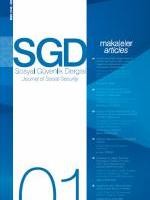İşsizlik Oranı Üzerindeki Şoklar Gerçekten Kalıcı mı: Türkiye Ekonomisi Üzerine Bir Analiz
Bu çalışma, Türkiye Ekonomisinde1988:Q3 ile 2015:Q3 dönemini kapsayançeyreklik frekansta mevsimsel ve takvimetkilerinden arındırılmış işsizlik serisindekalıcığı araştırmaktadır. Bu amaçlaLumsdaine ve Papell (1997) tarafındangeliştirilen birim kök testi kullanılarakişsizlik serisinin birim kök içerip içermediğiaraştırılarak bu serinin şoklara karşıgösterdiği tepki incelenmiştir. Çalışmadanelde edilen bulgular yapısal kırılmalar gözönünde bulundurulmadığında şoklarınişsizlik serisinde oldukça güçlü etkiye sahipolduğunu gösterirken yapısal kırılmalar gözönünde bulundurulduğunda, şoklarınişsizlik serisi üzerindeki, etkisininazaldığını göstermiştir.
Anahtar Kelimeler:
İşsizlik oranı, yapısal kırılmalı birim kök testi, histeri, kalıcılık
___
- Alogoskoufis, G. S. ve A. Manning (1988), “On the Persistence of Unemployment”, Econ. Policy 7, 427-469. Alogoskoufis, G.S.; Bean, C., G. Bertola, D. Cohen, J.J Dolado, ve G. Saint-Paul (1995), “Unemployment: Choices for Europe”, London, CEPR.
- Andrés, J. (1993), “La Persistencia Del Desempleo Agregado: Una Panorámica”, Moneda Crédito 197, 91-127.
- Arestis, P., Biefang-Frisancho Mariscal, I. (1999), “Unit Roots and Structural Breaks in OECD Unemployment”, Econ. Lett. 65 (2), 149-156.
- Arestis, P., Biefang-Frisancho Mariscal, I. (2000), “OECD Unemployment: Structural Breaks and Stationarity”, Appl. Econ. 32 (4), 399-403.
- Bean, C. (1994), “The Role of Demand Management Policies in Reducing Unemployment”, In: Unemployment, Reducing (Ed.), Current Issues and Policy Options, Kansas City, Federal Reserve Bank of Kansas City, 99-132.
- Bentolila, S. ve J.F. Jimeno (2006), “Spanish Unemployment: The End Of The Wild Ride?” In: Werding, M. (Ed.), Structural Unemployment in Western Europe: Reasons and Remedies, Cambridge (Mass.), MIT Press, 317-344.
- Bentolila, S.; Cahuc, P., J.J. Dolado, T. Le Barbanchon (2012a), “Two-Tier Labour Markets in the Great Recession: France Versus Spain” Econ. J. 122 (562), F155- F187.
- Bentolila, S.; Dolado, J.J., J.F. Jimeno (2012b), “Reforming an Insider-Outsider Labor Market: The Spanish Experience”, IZA J. Eur. Labor Stud. 1 (4), 1–29.
- Bentolila, S.; Dolado, J.J., J.F. Jimeno (2012c), “The “New” Newlabourmarket Reform in Spain: Objectives, Instruments and Shortcomings”, CESifo DICE Rep. 10 (2), 3-7.
- Bianchi, M. ve G. Zoega (1998), “Unemployment Persistence: Does The Size of the Shock Matter?”, J. Appl. Econ. 13 (3), 283–304.
- Blanchard, O.J. ve P. Diamond (1994), Ranking, Unemployment, Duration and Wages, Rev. Econ. Stud. 61 (3), 417–434.
- Blanchard, O.J. ve J.F. Jimeno (Eds.), (1995), “Unemployment in Spain: Is There a Solution?” London, CEPR.
- Blanchard, O.J. ve L. Summers (1986), “Hysteresis and the European Unemployment Problem”, NBER Macroecon. Annu. 1986, 15-78.
- Blanchard, O.J. ve L. Summers (1987), “Hysteresis in Unemployment”, Eur. Econ. Rev., 31 (1-2), 288-295.
- Blanchard, O.J. ve J. Wolfers (2000), “The Role of Shocks and Institutions in the Rise of European Unemployment: The Aggregate Evidence”, Econ. J. 110 (462), 1-33.
- Blanchard, O.J.; Jaumotte, F. ve P. Loungani (2014), “Labor Market Policies and IMF Advice in Advanced Economies During the Great Recession”, IZA J. Labor Policy 3 (1), 1-23.
- Camarero, M. ve C. Tamarit (2004), “Hysteresis vs. Natural Rate of Unemployment: New Evidence for OECD Countries”, Econ. Lett. 84 (3), 413-417.
- ISSN: 2146-4839
- Yayın Aralığı: Yılda 2 Sayı
- Yayıncı: T. C. Sosyal Güvenlik Kurumu
Sayıdaki Diğer Makaleler
İşsizlik Oranı Üzerindeki Şoklar Gerçekten Kalıcı mı: Türkiye Ekonomisi Üzerine Bir Analiz
Türker Topalhan, Ömer Tanju Durusoy, Zeynel Abidin Özdemir
İşyerlerinde ve İşletmelerde İş Sağlığı ve Güvenliği Hiyerarşisi
Kadınların İş-Aile Yaşamı Çatışmasını Engellemeye Yönelik Hukuki Düzenlemeler
İşçi Sigortaları Kurumunun Kuruluşu
Ülke Örnekleri ile Türkiye’de Yarı Zamanlı Çalışmanın Görünümü
Hastanelerde Maliyet Analizi: Kamu Hastanesi Örneği
Finansal Kuznets Eğrisi Hipotezi: G-7 Ülkeleri Örneği
